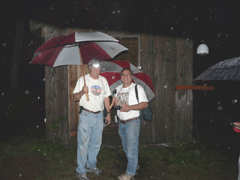Fly-by-Night Murder Mystery
Air Date: Week of October 24, 2008

Tom Kunz and Bruce Gellerman in front of the bat roost. (Photo: Bruce Gellerman)
Something is killing bats in the Northeast. Scientists have dubbed it “white nose syndrome” and believe a new fungus may be responsible for the mass die-off. On a dark and stormy evening, Living on Earth host Bruce Gellerman went out to crack the case.
Transcript
GELLERMAN: It’s Living on Earth, I’m Bruce Gellerman
[THUNDER AND HEAVY RAIN]
GELLERMAN: It was a dark and stormy evening, a pitch-black night, the kind that sends a shiver down your spine.
In the shadows, a mystery that’s baffling scientists across the country: virologists, mycologists, reproductive biologists, and immunologists: Why colonies of bats in the northeast are dying - whole caves full of ’em.
For answers I drove to Paxton, Massachusetts, and let me tell you, I quickly found out cracking this case was going to be tough going.
KUNZ: I went the wrong way. Hold it, we got to go up there…
GELLERMAN: Tom Kunz leads the way up slippery rocks and wet, thorny bushes and past a waterfall in Moore State Park. The rain pelts my umbrella and hits my mic, with a snap, crackle and pop.
Even with his headlamp and my flashlight it’s difficult seeing the path, but Kunz knows the way - he’s been coming here for nearly a quarter of a century. Kunz directs Boston University’s Center for Ecology and Conservation. He’s been studying nocturnal flying mammals since he was a kid. Kunz is a chiropterologist. His students simply call him: Batman.
KUNZ: I fell in love with bats…I thought this is the coolest thing I could ever do with my life, and I never turned back.
GELLERMAN: Pressing on we arrive at a weathered wood hut. It’s a maternity ward of sorts, filled with mom bats and their baby pups.

Tom Kunz (Photo: Bruce Gellerman)
KUNZ: So it’s a little bit bigger than a backyard shed. And as we go inside, we built a module that fits up in the attic of this building where the bats are roosting in crevices.
[SOUND OF DOOR OPENING]
GELLERMAN: It’s spooky inside. The rain has put a damper on the bats evening flight for food. Little brown bats like these can make more than 20 miles an hour flying like bats out of - well, you know…
KUNZ: You can see the feces on the ground here. And over here’s our equipment, our camera and computer. You can see a few bats flying…
GELLERMAN: Oh…oh…
KUNZ: …and you look up at the ceiling there see there…up there…That’s where they roost.
GELLERMAN: So about a thousand bats, you figure, in there?
KUNZ: Well, right now, with babies, there could be close to a thousand bats in here, yeah.
GELLERMAN: This colony seems okay, but Jonathan Reichard, a grad student in Professor Kunz’s lab, says in hibernaculum mines and caves in four northeast states, New York, Vermont, Connecticut and Massachusetts, bats that are supposed to be there are missing - whole colonies decimated.
REICHARD: In those mines they can’t necessarily account for all of the dead bats, they just know they’re not there, because they haven’t found the floors littered – in many cases, they haven’t found the floors littered with carcasses.
KUNZ: Two years ago - was the first time, it was the winter of 2006-2007.
GELLERMAN: Professor Tom Kunz says the first case was found in a cave near Albany, New York. The dieoffs were slow at the beginning.

Jonathan Reichard. (Photo: Bruce Gellerman)
KUNZ: It is very bizarre, yeah. Only in about four or five caves during that winter, did they see evidence.
GELLERMAN: But the evidence quickly mounted. Actually, it was a lack of evidence - missing bats. In some caves, a hundred percent gone. And when scientists did find bats, they found a weird white fungus growing on the face, wings and ears. Scientists dubbed it White Nose Syndrome. Professor Kunz calls it circumstantial evidence.
KUNZ: White Nose syndrome is, at least to the best of our knowledge right now, is sort of the external manifestation of whatever is causing these bats to become ill and die.
GELLERMAN: So it seems to me you’re not sure whether this is cause or effect - whether the fungus is a symptom, or it’s actually killing them?
KUNZ: Exactly.
GELLERMAN: For clues to why bats are dying, scientists are trying to understand more about how they live. Bats make up 20 percent of the mammal species, but there are huge gaps in our knowledge. Bats are no fly-by-night species. They play critical roles in the environment. The little brown bats here feast voraciously in the summer and fall, on insects.
KUNZ: Insectivorous bats typically eat anywhere between two thirds to their entire body weight in insects.
GELLERMAN: In one night - they eat two thirds of their entire weight…a night?
KUNZ: Yeah, Two-thirds to their entire weight, yeah, 100 percent – now, that’s a lot of eating. This would be equivalent of a hundred-pound person eating 400 quarter-pounders a night.
GELLERMAN: Bats make meals of moths, beetles, midges and flies, storing the fat, stocking up in the late fall - right about now - for winter. For six months they’ll hibernate in caves and mines, attics and sheds, living in a state of torpor, when the bat’s metabolism slows way down and their body temperatures drop. That’s the way it’s supposed to be - but Professor Kunz says scientist have found where there’s white nose syndrome something else is going on.

Tom Kunz and Bruce Gellerman in front of the bat roost. (Photo: Bruce Gellerman)
KUNZ: Basically what’s happening is by midwinter, these bats have lost all their body fat, in effect. So if you don’t have enough fat to sustain hibernation, you don’t have enough energy to arouse, and you die.
GELLERMAN: They’re just wasting…
KUNZ: They’re wasting away - that’s right - they’re exactly wasting away.
GELLERMAN: It may be the bats are affected by the white nose fungus in the fall and are too weak to gather enough insects for winter, or maybe the fungus is causing the bats to wake during hibernation.
It’s kind of like when you get athletes’ feet - it’s not going to kill you, but it’s going to irritate you. So there may be some level of irritation that these hibernating bats experience - which may cause them to become more active and arouse and so on. This is still a hypothesis.
GELLERMAN: Aroused early from hibernation - and starving - perhaps the bats fly off into the winter…and die.
Caves are cold, dank places and a hibernating bat is like a tub of cottage cheese in the back of a refrigerator - a perfect medium for fungus and bacteria. Over millions of years, bats have developed immunity to most molds and disease, but white nose is different. It’s new. It’s unlike any other fungus seen before, it thrives in very cold temperatures. And even in professor Kunz’s lab where undergraduate Katherine King works, there are conflicting theories about white nose and what’s causing the bats to die.
KING: Personally I think it’s a combination of changes in the environment, different changes that have been caused by human interaction and things like that I think the fungus is probably a secondary symptom of something that’s a problem in the bats - but we simply don’t have a clue as to what that is.
GELLERMAN: Well if it’s not the white nose syndrome that’s killing the bats, what is it?
KUNZ: Well I’ve got several hypotheses here.
GELLERMAN: Again, Batman - professor Tom Kunz.
KUNZ: It has to do with fat. And it has to do with insects and it has to do with other potential reasons why insect populations around the world are declining. You may or may not know this, but insect populations - in particular, moths and some beetles, for example in New York State, a little lady bug beetle is going down the tubes. So this leads to the hypothesis there’s a reduction in the number of insects that are available to bats during the fall of the year, when they need that fuel to deposit fat to successfully hibernate.
GELLERMAN: This is still just a hypothesis, just a theory, but one thing is certain: bats which are critical to holding the population of insects in check and play important roles in pollinating forests, are dying in large numbers in New England. And bats in caves could be like the canary in the coal mine.
Links
Living on Earth wants to hear from you!
Living on Earth
62 Calef Highway, Suite 212
Lee, NH 03861
Telephone: 617-287-4121
E-mail: comments@loe.org
Newsletter [Click here]
Donate to Living on Earth!
Living on Earth is an independent media program and relies entirely on contributions from listeners and institutions supporting public service. Please donate now to preserve an independent environmental voice.
NewsletterLiving on Earth offers a weekly delivery of the show's rundown to your mailbox. Sign up for our newsletter today!
 Sailors For The Sea: Be the change you want to sea.
Sailors For The Sea: Be the change you want to sea.
 The Grantham Foundation for the Protection of the Environment: Committed to protecting and improving the health of the global environment.
The Grantham Foundation for the Protection of the Environment: Committed to protecting and improving the health of the global environment.
 Contribute to Living on Earth and receive, as our gift to you, an archival print of one of Mark Seth Lender's extraordinary wildlife photographs. Follow the link to see Mark's current collection of photographs.
Contribute to Living on Earth and receive, as our gift to you, an archival print of one of Mark Seth Lender's extraordinary wildlife photographs. Follow the link to see Mark's current collection of photographs.
 Buy a signed copy of Mark Seth Lender's book Smeagull the Seagull & support Living on Earth
Buy a signed copy of Mark Seth Lender's book Smeagull the Seagull & support Living on Earth

